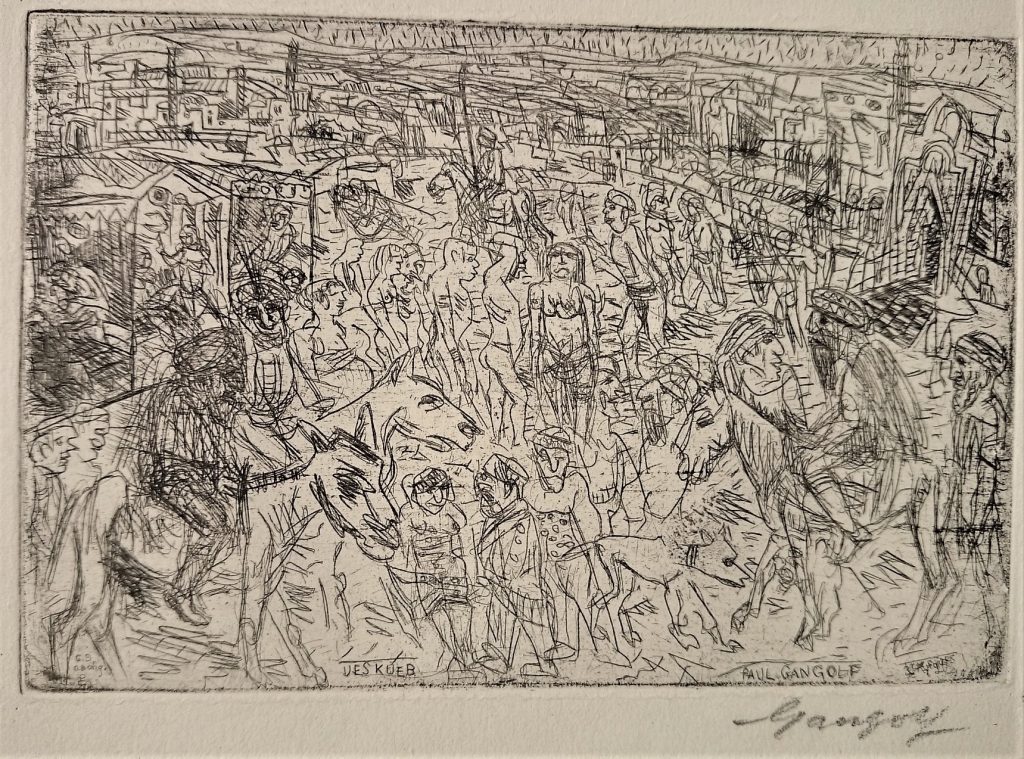Paul Gangolf (born October 13, 1879 in Königsberg (Prussia) , died August 12, 1936 in Esterwegen ) was a German artist of Expressionism . Among other things, he worked as a lithographer, wood cutter, etcher, painter, collage artist and art writer.
Paul Gangolf was born as Paul Löwy in Königsberg in 1879. The family was Jewish. Paul Löwy spent his youth in Wiesbaden. From 1901 he lived in Berlin. It is not known when he used the stage name Gangolf.
Gangolf trained as a bookseller. The Hamburg collector Gustav Schiefler acquired a small oil sketch from Gangolf in 1912/13 and planned to create a catalogue of works on Gangolf’ s prints, as he had previously done for Ernst Ludwig Kirchner, Emil Nolde, Max Liebermann and Edvard Munch, among others. With the death of Schiefler in 1935, this plan was never realized.
In 1913 Gangolf stayed in Jersey and travelled through France.
During the First World War he served as a volunteer recruit in Ihringen. In 1915 he was a soldier in Wismar and the following year in Macedonia.
From 1919 Gangolf was again based in Berlin. He was primarily concerned with lithography. In the same year the first Paul-Gangolf portfolio appeared. Through the intermediation of Schiefler, the Hamburger Kunsthalle acquired some works from him. In 1923 the Metropolis portfolio was published by the Malik publishing house in Berlin and the city map by Oskar Wöhrle in Constance. From 1926 further works appeared in the Berlin Euphorion publishing house by Ernst Rathenau (1897-1986).
In 1926 Gangolf moved to Paris, financially supported by Heinrich Stinnes . There he occasionally took part in exhibitions. After 1930, Gangolf’s situation worsened considerably. He lived temporarily in London, returned to Paris and lived again in Berlin from August 1932. In the spring of 1933, he had an exhibition in the art club. Gangolf was arrested after the NSDAP came to power as a result of a denunciation on the open street in Berlin, spent several months in the Columbia House concentration camp and was deported to the Esterwegen concentration camp. At the end of May 1935, he was shot and treated in the Sörgel hospital. In August 1936 he was again sent to the Esterwegen concentration camp and shot on August 12, 1936 in a nearby forest.
Works by Gangolf are in the Museum of Modern Arts in New York , in the Los Angeles County Museum of Art, the National Gallery of Art, in Kettle’s Yard, in the British Museum, in the Scottish National Gallery and in the Hamburger Kunsthalle .
Gangolf has also been exhibited in the Ernst Barlach House.
One example of his Macedonian graphics is the etching called “Ueskueb” (Skopje) sold by the auction house Peter Kiefer, Pforzeim , Germany, on 18 October 2014 ( lot number 7242) tо the author of this lexicon
